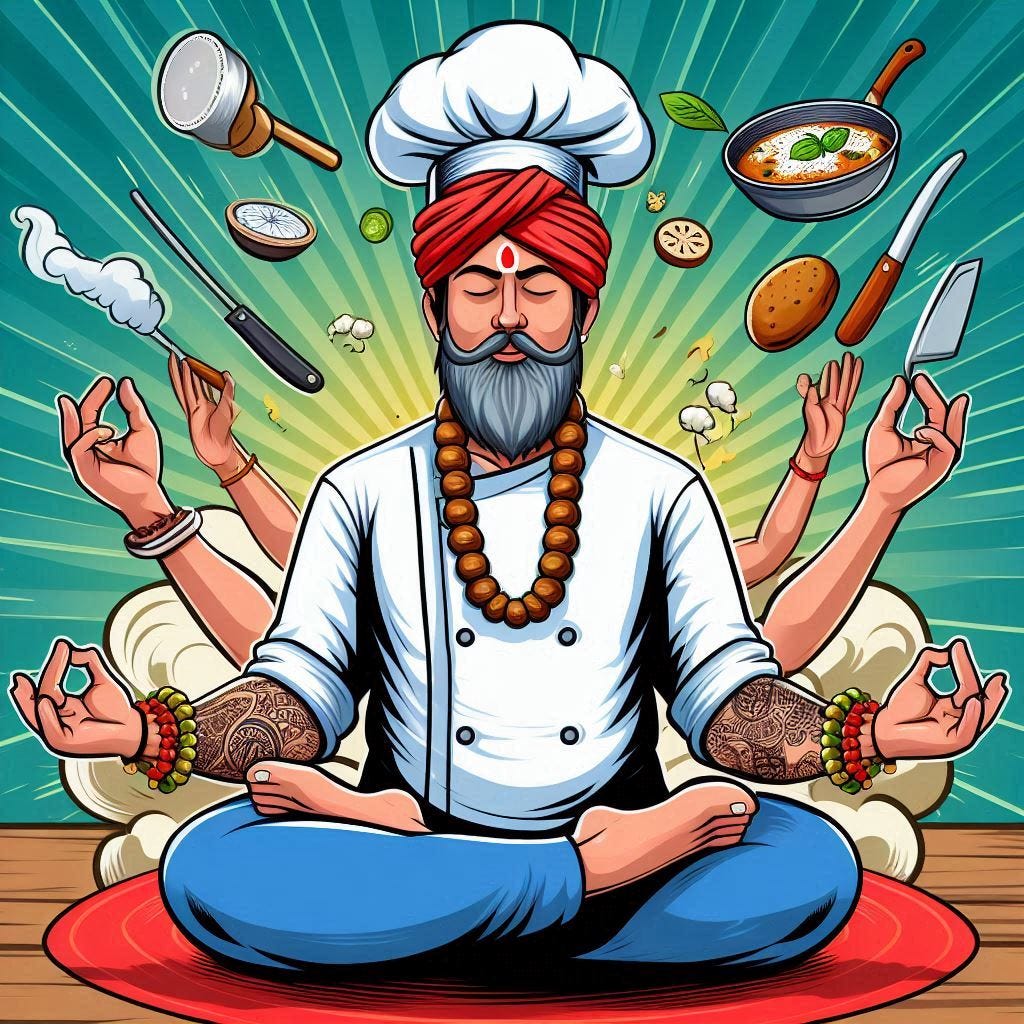improv exercise: find the simple statement
which ingredients or techniques are actually driving most of the results?
In improv comedy there’s a game called “Half-Life” that gets at a deep truth about creative work. You do a two minute scene based on an audience suggestion. Then you do the same scene in one minute. Then in 30 seconds, then once again in 15 seconds, then in 7, then in 3.
The 15 and 7 second scenes are often the strongest.
For that first scene, the long one, you’re doing the normal improv things of yes-anding, giving gifts, having a character, and so on. But for the subsequent scenes you’re thinking in a different mode. You’re asking yourself what made that first scene work, what was important, what needs to be said and what can be discarded. It forces you to evaluate and decide.
To decide: from Latin decidere, literally "to cut off," from de "off" + caedere "to cut".
That first scene probably had something good in it, but forcing performers to make it short amplifies the good stuff and gets rid of the fluff.
In painting and drawing this concept shows up all the time. Nathan Fowkes calls it the simple statement: the big shapes of light and dark that communicate what’s happening in a painting. Here’s how important he thinks this is:
Let me repeat it because this "simple statement" paint-over describes the most important thing I know about drawing. So few people ever master drawing because they don't know or are not willing to find the simple masses and relationships underneath all the complexity they can see. Everyone notices how the parts contrast from the whole, but you have to forcibly train yourself to do the opposite, to notice how the parts most simply relate the the whole as described in this final image.
Andy Evansen advocates value sketches, Arthur Wesley Dow suggests Notan studies, and every drawing teacher tells you to squint so you can see big shapes and ignore the details.
This is related to the Pareto principle, that 80% of results come from 20% of the work. I’m pedantic so I find that statement icky. Those numbers can’t actually be right in all cases! But there’s a big truth that it communicates, which is that most of the impact of a business plan or painting or improv scene or recipe comes from just a few decisions.
I want you to think about what those decisions are.
please shut up about painting and improv and talk to me about cooking
Improvisational cooking sounds like you go in the kitchen and get a bunch of ingredients and just start doing whatever. No recipe. That sounds scary because how are you supposed to know what to do? It demands that you make a bunch of creative decisions on the fly.
But the truth is that there’s a lot you can do to prepare for that moment of performance. And most of the training doesn’t demand that you make a bunch of decisions on the fly. Instead of memorizing recipes, you’re learning fragments of recipes, techniques, how different ingredients behave, what things taste good together, how heat affects things, how to salvage various disasters, stuff like that.

The trouble is that there aren’t that many books full of fragments and techniques and stuff for you to memorize, at least not for Indian food. You can watch Alton Brown’s old TV show, you can read Kenji’s old articles or read his book. Nathan Myhrvold’s stuff is quite useful, Samin Nosrat’s book is great, and I’ve heard good things about Sohla El-Waylly’s new book. But I don’t know of anything quite like that for Indian food — tell me if you know of something!
So how do you learn to improvise from the many incredible books full of Indian recipes?
Exercise 1: ingredient triage
Read, or, ideally, make a recipe. Then ask yourself, If I had to cut 1 ingredient, which one would it be? What if I had to cut 3? What about 5?
(It’s possible that these don’t form perfect subsets of each other: there might be an ingredient you’d cut if you needed to get rid of 3, but include if you were cutting 5.)
Actually make the simpler versions, at least a few of them. Compare to the original. You might be surprised! Simpler food can often taste better.
When I apply this to written recipes I often discover why the author decided to use this or that ingredient: dropping cilantro showed me what something tastes like without a herby fresh touch, cutting turmeric taught me its mellow flavor and appealing look, skipping coriander powder made me realize its textural importance.
Whenever I apply this to something I improvise, I usually end up with something better. Complexity precedes simplicity.
Here’s a different version:
Exercise 2: process triage
Instead of cutting ingredients, see if you can reduce the number or complexity of steps in the recipe.
What happens if you skip marinating? Is the flavor that much worse if you add all the vegetables together instead of in order? Can you really tell the difference between sliced and minced onions? Forget slicing, what if you just halved the onions and stuck em in the stew? What if you don’t soak the legumes? What if you don’t rest the dough? What if you just add all the spices together? What if you just dump everything in a pressure cooker and let ‘er rip?
These exercises train you to be comfortable with failure. You’ll make a lot of bad food, and that’s okay! Not only is it ok, it’s actually necessary:
I will put you through hell because jizzworthy chemistry does not come from sitting around drinking coffee and singing in the choral society. It takes FAILURE FAILURE FAILURE FAILURE, and then, maybe, if you keep failing, eventual success. Organic chemistry is all about trial and error, creating luck. That, and a lot of fucking columns. I will push you to the limits of your capabilities, and then some. You will hate it at first. But over time, you will adjust. You will be forged into a hardened lethal weapon of organic chemistry effectiveness. You will become a chemistry navy seal. There will be nothing you can’t do. You will surprise yourself with what you can accomplish. You will push through barriers you’ve been struggling with your entire life and finally achieve your full potential. That whiny voice you have in the back of your mind that says “I can’t do it!”? You are going to stomp on its face with steel-spiked boots.
What is cooking if not a form of organic chemistry? As you do these exercises you can take notes if you want. But it’s also fine to just trust your big powerful brain to remember what’s important and discard what’s not.
Over time you will isolate fragments and cores of recipes that you like. Once that happens:
Exercise 3: ornamentation
Now that you’ve made simpler versions, add complexity back, but in a different direction than the original recipe.
If you removed some spices, add back in some other spices. If you removed an herb, use a different herb. Or garnish with a non-herb, like a tadka or fried allium. If you got rid of something that provided crunch or small-grained texture, add chopped nuts.
You will discover that ornamenting will initially make the food a little better, but then dramatically worse. At first rococo, then rubble.
In doing these exercises you’re playing with different amounts of complexity. Ask yourself whether that complexity was worth it. If there’s a simpler recipe that is more delicious than any of its more complex counterparts, you’ve found something that dominates (both in the colloquial and math senses). But there’s usually a real trade-off between flavor and complexity. I want you to begin to build a sense for recipes that achieve the best result for a fixed amount of complexity.
Math nerds will recognize this as the concept of Pareto efficiency: recipes where achieving better flavor demands an increase in complexity. Together, these constitute a Pareto frontier of Good Recipes.

I’m too lazy to make a diagram so here’s an example of a food-related Pareto frontier I found on the internet:
There will come rare, memorable moments in your life where you will discover a new ingredient or skill, and your entire world will change. Technological progress. A permanent shift of your Pareto frontier. Bliss.






